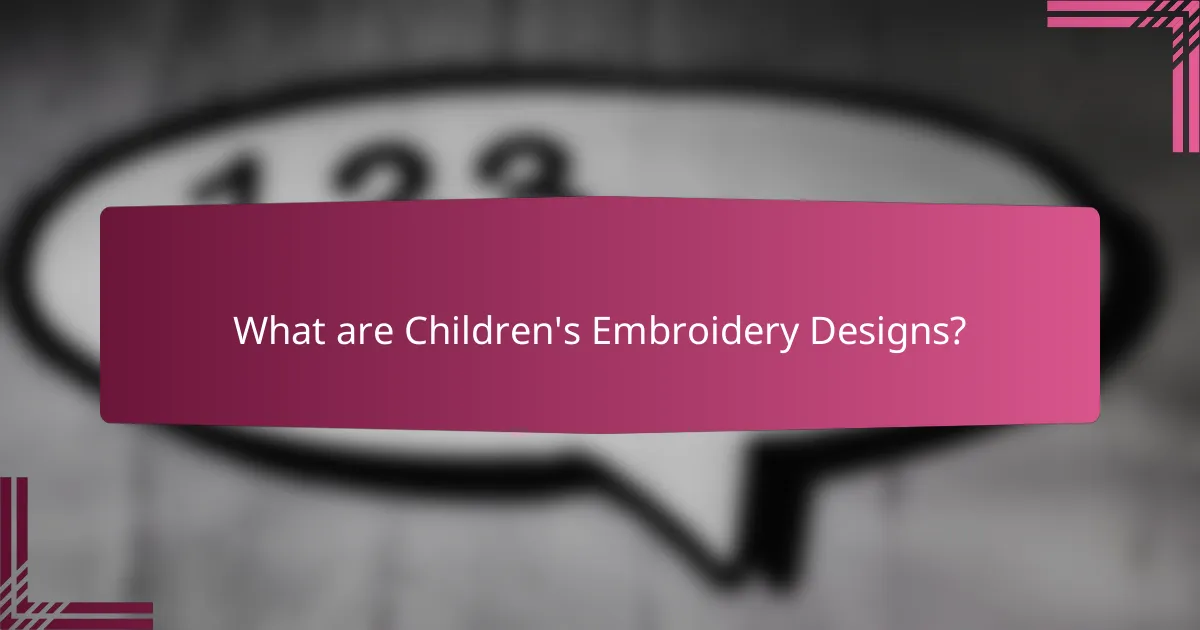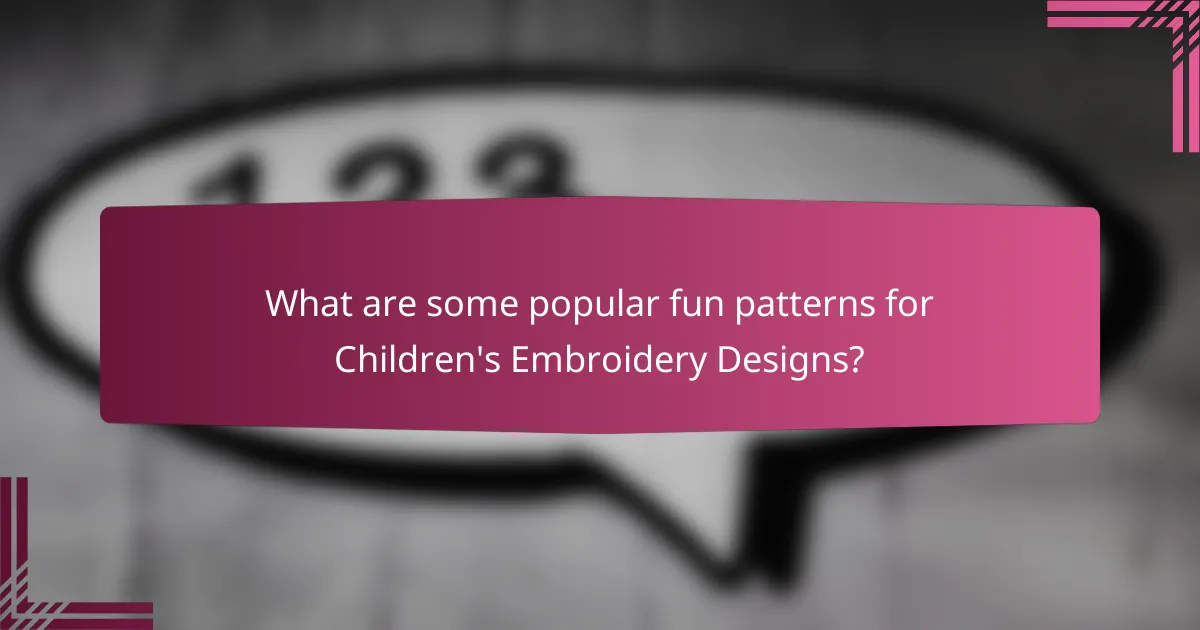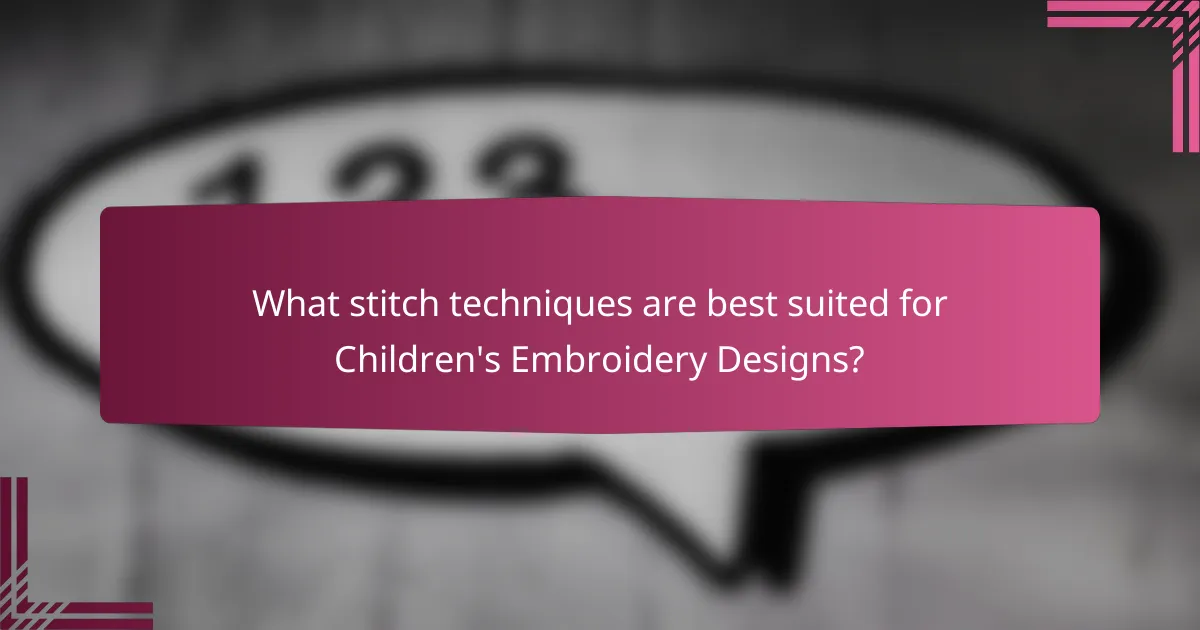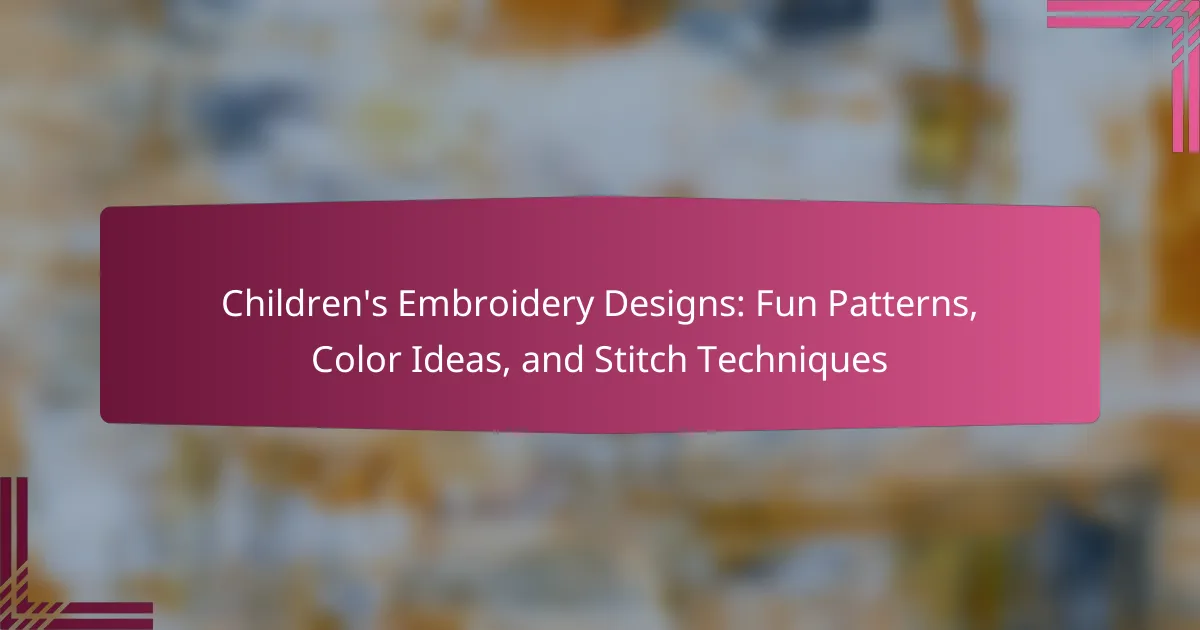
What are Children’s Embroidery Designs?
Children’s embroidery designs are decorative patterns created specifically for children’s clothing and accessories. These designs often feature playful themes, such as animals, cartoons, and nature. They are crafted to appeal to young audiences and can be used on various fabric items. Common attributes include bright colors and whimsical shapes. The designs may also incorporate educational elements, fostering learning through visual art. Many children’s embroidery designs are simplified for easier stitching. This makes them accessible for beginner embroiderers. Overall, they enhance the aesthetic of children’s garments while providing a fun creative outlet.
How do Children’s Embroidery Designs differ from traditional embroidery?
Children’s embroidery designs differ from traditional embroidery in their simplicity and playfulness. They often feature bright colors and whimsical themes. Traditional embroidery tends to focus on intricate patterns and detailed designs. Children’s designs prioritize fun and ease of execution. This makes them more accessible for young crafters. For example, children’s designs often use basic stitches. Traditional embroidery may employ advanced techniques that require more skill. Additionally, children’s designs frequently incorporate characters or themes from popular culture. Traditional embroidery usually reflects historical or cultural motifs. These differences cater to the interests and abilities of children versus adults.
What unique characteristics define Children’s Embroidery Designs?
Children’s embroidery designs are characterized by vibrant colors, playful themes, and simplified patterns. These designs often feature cartoon characters, animals, and whimsical motifs. The use of bold, contrasting colors makes the designs visually appealing to children. Additionally, the patterns are typically less intricate to accommodate younger skill levels. Materials used are often soft and safe for children’s clothing. The stitches are usually straightforward, such as satin or backstitch, to ensure ease of creation. These unique characteristics cater to the interests and developmental stages of children.
Why are themes and motifs important in Children’s Embroidery Designs?
Themes and motifs are crucial in children’s embroidery designs because they enhance visual storytelling. They capture children’s interests and imaginations, making the designs more engaging. Specific themes, such as animals or nature, resonate with children’s experiences. Motifs can also aid in educational contexts, teaching concepts like colors and shapes. Furthermore, consistent themes create a cohesive look, making the embroidered items more appealing. Studies show that children respond positively to familiar themes, which can increase their emotional connection to the items. This connection fosters creativity and encourages children to express themselves through art.
What are the benefits of creating Children’s Embroidery Designs?
Creating children’s embroidery designs offers numerous benefits. It enhances fine motor skills as children manipulate needles and threads. This activity fosters creativity by allowing kids to express their artistic ideas. Additionally, it promotes focus and concentration through the detailed work involved. Children also gain a sense of accomplishment upon completing a project. Furthermore, embroidery can serve as a bonding activity between parents and children. Engaging in this craft can also introduce children to cultural traditions associated with embroidery. Overall, these benefits contribute to a well-rounded developmental experience for children.
How do Children’s Embroidery Designs promote creativity in kids?
Children’s embroidery designs promote creativity in kids by encouraging self-expression through artistic choices. These designs allow children to select colors, patterns, and stitches that reflect their personal style. Engaging in embroidery enhances fine motor skills as kids manipulate needles and threads. This hands-on activity fosters problem-solving skills when they encounter challenges in their projects. Studies show that creative activities like embroidery can boost confidence in children as they complete their work. Additionally, embroidery provides a sense of accomplishment, motivating kids to explore their creativity further. Ultimately, children’s embroidery designs serve as a medium for imaginative exploration and skill development.
What skills can children develop through embroidery projects?
Children can develop various skills through embroidery projects. These skills include fine motor skills, as threading needles and manipulating fabric require precision. Problem-solving abilities are enhanced when children plan their designs and troubleshoot issues. Creativity flourishes as they choose colors and patterns. Attention to detail improves through careful stitching and pattern following. Patience is cultivated as projects may take time to complete. Lastly, children learn about responsibility by taking care of their materials and finishing their projects.

What are some popular fun patterns for Children’s Embroidery Designs?
Popular fun patterns for children’s embroidery designs include animals, cartoon characters, and nature themes. Animal patterns often feature cute designs like puppies, kittens, and farm animals. Cartoon character patterns are inspired by popular children’s shows and movies. Nature themes can include flowers, trees, and butterflies. Other fun patterns include stars, hearts, and whimsical shapes. These designs appeal to children’s interests and enhance their clothing or accessories. Many embroidery books and online resources showcase these popular patterns for easy reference.
What types of themes are commonly used in Children’s Embroidery Patterns?
Common themes in children’s embroidery patterns include animals, nature, and fantasy. Animal themes often feature popular creatures like cats, dogs, and elephants. Nature themes may include flowers, trees, and insects. Fantasy themes often showcase elements like fairies, unicorns, and magical landscapes. Other prevalent themes are educational motifs, such as letters and numbers, which help in learning. Seasonal themes also appear, representing holidays and seasonal changes. These themes cater to children’s interests and encourage creativity.
How can seasonal themes enhance Children’s Embroidery Designs?
Seasonal themes can significantly enhance children’s embroidery designs by adding relevance and excitement. These themes allow for the incorporation of colors and motifs that resonate with specific seasons. For example, spring designs can feature flowers and pastel colors, while winter themes may include snowflakes and rich blues.
This seasonal variation keeps children’s interest alive and encourages creativity. Additionally, seasonal themes can be tied to holidays, such as Halloween or Christmas, providing opportunities for themed projects. Engaging with these themes can also help children learn about seasonal changes and cultural celebrations.
Research indicates that children respond positively to visually stimulating designs that reflect their environment. The integration of seasonal themes in embroidery can foster a sense of connection to nature and traditions. Thus, using seasonal themes makes children’s embroidery designs more dynamic and educational.
What are some animal motifs that appeal to children?
Animal motifs that appeal to children include popular choices like elephants, lions, and dolphins. These animals are often depicted in bright colors and friendly designs. Elephants symbolize strength and wisdom, making them engaging for kids. Lions represent bravery and adventure, appealing to children’s imaginations. Dolphins are playful and intelligent, often associated with fun and joy. Other beloved motifs include cats, dogs, and bears, which are commonly found in children’s stories and cartoons. These animals resonate with children’s interests and emotions, making them ideal for embroidery designs.
How can color ideas enhance Children’s Embroidery Designs?
Color ideas can significantly enhance children’s embroidery designs by making them more visually appealing. Bright and vibrant colors attract children’s attention and stimulate their imagination. Using a variety of colors can create engaging patterns that encourage creativity. For example, contrasting colors can highlight specific elements in a design, making them stand out. Additionally, color combinations can evoke emotions and convey themes, such as joy or playfulness. Research shows that colorful designs can improve children’s mood and interest in activities. Overall, thoughtful color choices can transform simple embroidery into captivating art that resonates with children.
What color palettes are most appealing for children’s projects?
Bright and vibrant color palettes are most appealing for children’s projects. Popular combinations include primary colors like red, blue, and yellow. Pastel colors such as light pink, mint green, and baby blue are also favored. These palettes are visually stimulating and engaging for children. Research shows that children respond positively to colors that are bold and saturated. For instance, studies indicate that bright colors can enhance mood and creativity in young children. Using a mix of warm and cool tones can create a balanced and inviting look. Overall, these color choices facilitate better engagement in children’s projects.
How do colors affect the overall mood of an embroidery design?
Colors significantly influence the overall mood of an embroidery design. Bright colors like yellow and orange evoke feelings of happiness and energy. In contrast, cooler colors such as blue and green tend to create a calm and serene atmosphere. The choice of colors can also reflect themes; for instance, pastel colors often convey softness and innocence, making them ideal for children’s designs. Research indicates that color psychology plays a crucial role in design perception. According to a study by Satyendra Singh in the Journal of Management and Marketing Research, 90% of snap judgments made about products are based on color alone. This highlights the importance of selecting appropriate colors to achieve the desired emotional response in embroidery designs.

What stitch techniques are best suited for Children’s Embroidery Designs?
The best stitch techniques for children’s embroidery designs include satin stitch, backstitch, and split stitch. Satin stitch provides a smooth finish and vibrant color, making it ideal for filling shapes. Backstitch creates defined outlines that are easy for children to recognize. Split stitch offers a textured look and works well for detailing. These techniques are user-friendly and suitable for various fabric types. Their simplicity ensures that children can engage with embroidery without frustration. Additionally, these stitches allow for creativity in design, encouraging artistic expression.
What are the basic stitch techniques every child should learn?
The basic stitch techniques every child should learn include the running stitch, backstitch, and whip stitch. The running stitch is a simple stitch that creates a straight line of small, even stitches. It is foundational for many embroidery projects. The backstitch provides a strong, continuous line and is often used for outlining shapes. The whip stitch is useful for sewing edges together and finishing seams. These techniques are essential for developing embroidery skills and understanding fabric manipulation. Mastering these stitches allows children to create a variety of designs and patterns in their projects.
How do different stitches impact the texture of the design?
Different stitches significantly impact the texture of the design. Each stitch type creates a unique surface effect. For example, a satin stitch produces a smooth and shiny finish. In contrast, a running stitch offers a more textured and linear appearance. The choice of stitch affects how light interacts with the design. This interaction can enhance or diminish visual interest. Research shows that texture influences perception and engagement in art. Thus, varying stitches can make children’s embroidery more appealing.
What are some fun stitch techniques that children can try?
Children can try several fun stitch techniques, including the running stitch, backstitch, and whip stitch. The running stitch is simple and involves making small, even stitches in a straight line. This technique helps children learn control and consistency. The backstitch creates a solid line by stitching backward, which is great for outlining shapes. The whip stitch is useful for sewing edges together, making it a practical choice for finishing projects. These techniques are engaging and help develop fine motor skills in children.
How can parents assist children in their embroidery projects?
Parents can assist children in their embroidery projects by providing guidance and support. They can help select appropriate patterns that match the child’s skill level. Parents can also gather and prepare materials, ensuring that children have the necessary supplies. Demonstrating basic stitching techniques can enhance the child’s understanding. Encouragement during the process fosters confidence and creativity. Setting up a comfortable workspace can improve focus and enjoyment. Lastly, parents can participate in the project, making it a fun bonding experience.
What tools and materials are essential for children’s embroidery?
Essential tools and materials for children’s embroidery include embroidery hoops, needles, and thread. Embroidery hoops hold the fabric taut for easier stitching. Needles should be child-friendly, such as blunt-tipped or embroidery needles. Thread can be cotton or embroidery floss, available in various colors. Fabric choices include cotton or felt, which are easy to work with. Scissors are necessary for cutting thread and fabric. Marking pens or pencils help outline designs before stitching. Lastly, a storage box keeps all materials organized. These items ensure a safe and enjoyable embroidery experience for children.
How can parents encourage children to experiment with their designs?
Parents can encourage children to experiment with their designs by providing them with a variety of materials. Access to different fabrics, threads, and tools fosters creativity. Setting aside dedicated time for crafting allows children to explore without pressure. Parents should praise their efforts to build confidence in their design choices. Introducing design challenges can stimulate innovative thinking. Sharing inspiring examples of embroidery can spark new ideas. Engaging in collaborative projects encourages teamwork and idea sharing. Lastly, allowing children to make mistakes teaches resilience and problem-solving.
What are some tips for successful Children’s Embroidery Projects?
Choose simple patterns for children’s embroidery projects. Simple designs are easier for kids to manage. Use bright, engaging colors to capture their interest. Bright colors make the project more visually appealing. Select child-friendly materials, such as cotton or felt. These materials are safe and easy to work with. Teach basic stitches like running stitch and backstitch. Basic stitches are foundational and build confidence. Encourage creativity by allowing children to personalize their projects. Personalization fosters a sense of ownership and pride. Supervise closely to ensure safety while using needles. Supervision prevents accidents and promotes a safe crafting environment.
How can children choose the right design for their skill level?
Children can choose the right embroidery design by assessing their skill level. Beginners should select simple patterns with few colors and basic stitches. Intermediate children can attempt designs with more intricate details and varied colors. Advanced children may choose complex patterns that incorporate multiple techniques. It is essential for children to consider their comfort with different stitches. They should also evaluate the time they can dedicate to a project. Choosing a design that aligns with their experience ensures a positive crafting experience. This approach fosters confidence and encourages skill development in embroidery.
What common mistakes should be avoided in Children’s Embroidery?
Common mistakes in children’s embroidery include using inappropriate thread types. Non-washable threads can lead to fading and damage. Another mistake is selecting overly complex patterns. Simpler designs are more suitable for children’s skill levels. Not securing the fabric properly is also a frequent error. Loose fabric can cause uneven stitches and frustration. Ignoring the importance of proper needle size is another issue. Using the wrong needle can damage the fabric. Lastly, neglecting to teach proper stitching techniques can result in poor-quality work. Educating children on these basics can enhance their embroidery experience.
Children’s embroidery designs are decorative patterns tailored for children’s clothing and accessories, featuring playful themes like animals and cartoons. This article explores the unique characteristics of these designs, highlighting their vibrant colors and simplified patterns that cater to young crafters. It also discusses the benefits of creating embroidery, including skill development and creativity enhancement, as well as popular patterns, stitch techniques, and tips for successful projects. Additionally, the article emphasizes the importance of themes and color choices in engaging children’s interests and promoting artistic expression.
